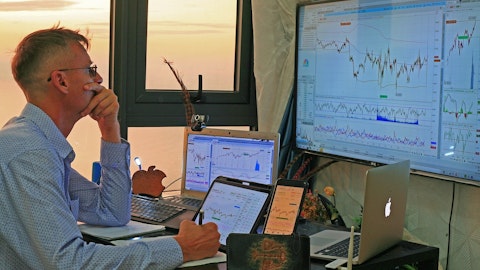Maria Pope: Thank you. Good morning. With regard to the rate case coming up, do you have any sort of early thoughts on level of rate increase or sort of thoughts on affordability heading into that?
Joe Trpik: Hey, Greg. Good morning. Obviously, we start our case here always thinking about affordability to the customer, also considering we’ve had a previous case here. We — I would expect, in this case, truly the focus is going to be on the batteries, the assets that have been put in service to continue to advance both reliability, expand capacity on the system as well as small amounts of cost. I mean I think this will mainly be truly just an infrastructure update to the plan focused on affordability.
Gregg Orrill: Got it. Thank you.
Operator: Thank you. Our next question comes from Paul Fremont with Ladenburg Thalmann. Your line is now open.
Paul Fremont: Thank you very much and thank you for taking my questions. I guess my first is given the storm deferrals for January, is that something that you would be looking to recover in the rate case that you’re filing currently? Or would that fall outside the purview because of — it’s too recent?
Joe Trpik: Good morning, Paul. So the storm recovery actually will fall through two separate processes than the general rate case. They’ll both be existing mechanisms. So the — as it relates to the operating costs, sort of and the reconstruction costs, those will come through a deferral rider that will be filed and will have its own proceeding, which is — and then the — as it relates to the cost of the energy and the RCE event, that will go through the PCAM process. Each will have a bit of a different time frame. For example, the PCAM process would not be filed until 2025 with the recovery of that, that would work itself into 2026.
Paul Fremont: And then the timing on the OpEx recovery, does that — would that normally occur within a year’s time or shorter than that?
Maria Pope: That recovery will be up to discretion with the commission. Normally, these storms are recovered over due to their magnitude and the significance over an extended period. The last time we had a storm recovery of this nature was recovered over 7 years. And what we will also — to just — I would say, we’ll also look through the eligibility for either of these for securitization, which will obviously can change the recovery stream as well.
Paul Fremont: Okay. And then looking at the higher base CapEx, how should we think about that relative to your bidding into the renewable RFP? Would you be looking to win less in the RFPs given sort of the magnitude of the CapEx increase? Or would there be sort of no change in terms of your business strategy?
Maria Pope: So our bidding strategy today, our bidding strategy going forward and our bidding strategy in the past has always been the same, and that is to have the most competitive projects for the least cost and least risk for customers. And those projects are winners, they’re good for customers, and they’re good for financing.
Paul Fremont: Okay. And then it looks like there’s a $200 million to $300 million annual increase in CapEx each year. Should we look at the incremental amount of spending as being funded roughly 50% with equity? Is that sort of a fair way to think about the financing?
Joe Trpik: I think when we look to the long-term financings here, we continue to look to over sort of using flexibility, manage our capital structure, continue to move towards 50-50. So assumption that over time, you’d say that would be looked at that balance level, it would be a reasonable way to look at it.
Paul Fremont: Great. And then my last question is a big step up, I think, in transmission and spend in ’28. And I was just wondering what — sort of what’s the explanation of that.
Maria Pope: Sure. That’s the — an answer to Julien’s question earlier, that’s the Pelton [indiscernible] to 230 — planned to be increased to 500 kV in partnership with the confederated tribes of the Warmer Springs. We previously announced a $250 million grant for that work from the Department of Energy. Obviously, that project would cost more than $250 million. It’s over 100 miles long, and it would be a multiyear project, the first year we’re anticipating in 2028.
Paul Fremont: So would the level of transmission spending sort of stay at that higher level for several years?
Paul Fremont: Probably for a couple of years after that in 2029, 2030. The transmission line and the increase also opens up a good portion of the central part of Oregon for additional renewable development in partnership with the tribes. We currently co-own several hydro facilities with them. And so this will allow for a significant expansion, particularly of solar energy, but really making the central part of Oregon and the Confederated Tribes of the Warm Springs Reservation, an opportunity for further development through 2028 and beyond.
Paul Fremont: And then my last question, with sort of the step up in CapEx, what type of rate base does that give you on a percentage basis through ’28?
Joe Trpik: So Paul, in the sort of the sister document that we also filed this morning, for the base capital, which includes the transmission, which includes the line that Maria just mentioned, that would put us at right around an 8% rate base growth. And then we’ve also, in that update, made some scenarios regarding an [indiscernible] outcome and in that update would put you with a 25% outcome, would put you at a 9.2% rate base through ’28.





